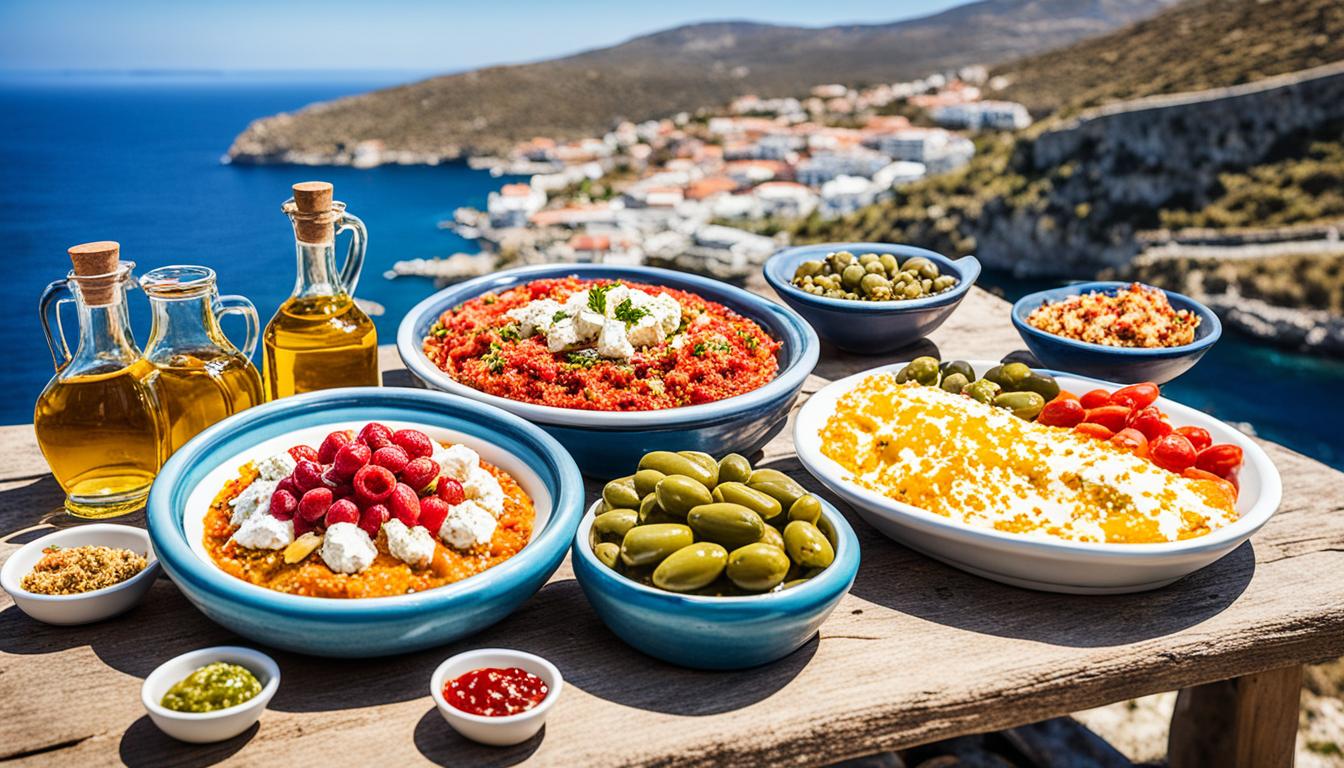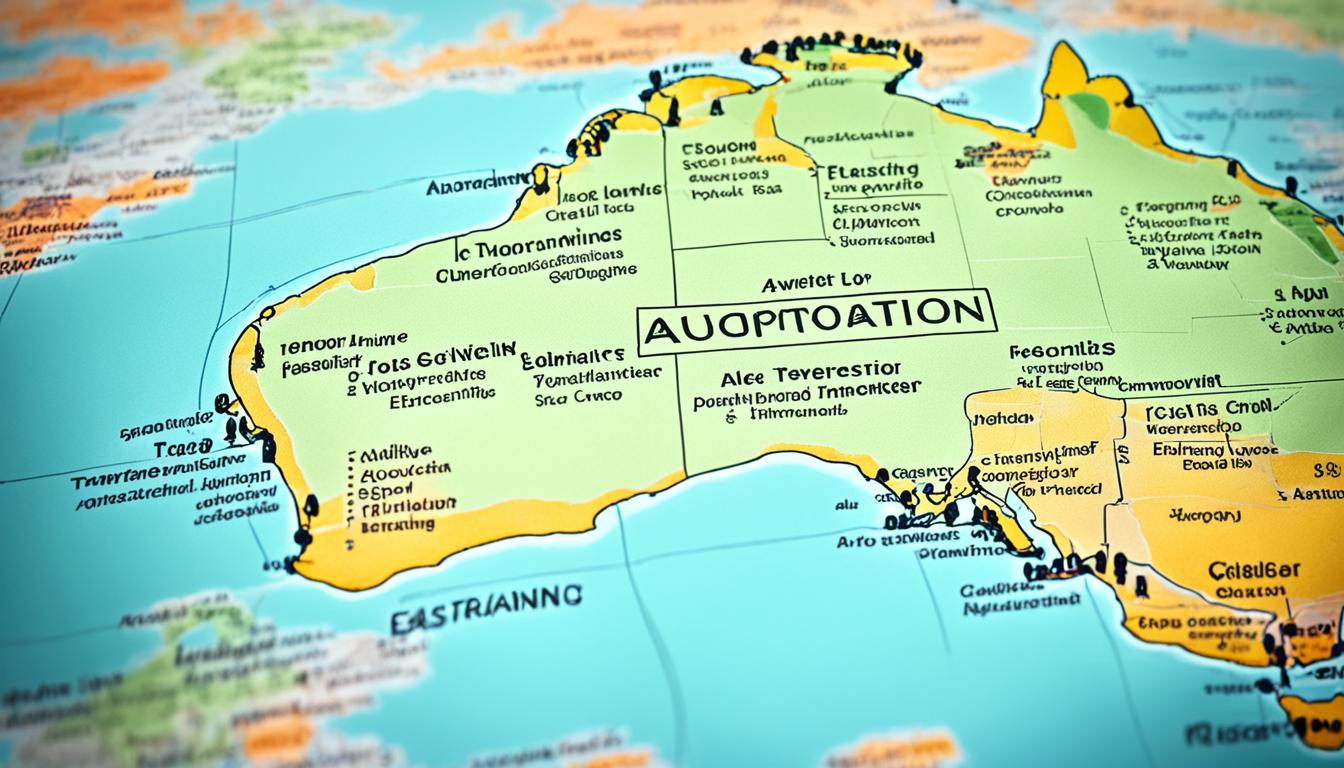
Are you ready to embark on a culinary adventure like no other? Look no further than the beautiful island of Crete. With its rich food culture and traditional Cretan dishes, Crete is a paradise for food lovers. From the freshest local ingredients to time-honored recipes, Crete’s cuisine is a delightful mix of flavors and textures that will tantalize your taste buds.
Crete’s cuisine is deeply rooted in its agricultural heritage, with a focus on utilizing the island’s bountiful produce. From juicy tomatoes and sweet honey to creamy cheeses and aromatic herbs, every dish tells a story of the land and its people. Whether you’re exploring the bustling markets or dining at one of the top restaurants, you’ll discover the true essence of Crete through its food.
Indulge in Cretan cheeses, such as the nutty graviera or the creamy myzithra, and experience the depth of flavor that comes from using fresh sheep or goat’s milk. Sample dakos, a Cretan twist on bruschetta, topped with grated fresh tomato and drizzled with Cretan olive oil. And don’t miss out on the fried snails, a delicacy that showcases the culinary diversity of the island.
For a truly unique flavor combination, try the Cretan cheese pies known as Kaltsounia. These small pies are filled with luscious Cretan cheeses like myzithra and drizzled with Cretan honey, offering a perfect balance of sweet and savory. And if you’re a fan of lamb, don’t miss the opportunity to savor lamb with stamnagathi, a wild green that adds a unique touch to the dish.
As you explore the Cretan food scene, be sure to also indulge in Gamopilafo, a rice dish traditionally served at Cretan weddings. Made with rich meat broth, lemon juice, and stakovoutiro, a butter made from boiled fresh goat’s milk, this dish is a true delicacy. And don’t forget to try Sfakia pies, a unique treat from the southern part of Crete, filled with fresh, soft cheese and drizzled with thyme or heather honey.
Pair your meal with Cretan brandy, known as Raki or Tsikoudia, for a traditional drink experience. Distilled from grapes, this grape brandy is enjoyed in shot glasses alongside mezes, olives, or barley rusks.
When it comes to exploring the Cretan food scene, there are plenty of top restaurants and unique culinary experiences to choose from. Whether you visit Palazzo Almare, Olive Oil Experience, or Manousakis Winery, you’ll be treated to a true feast for the senses.
Key Takeaways:
- Crete offers a rich food culture and traditional Cretan dishes.
- Explore the variety of Cretan cheeses, like graviera and myzithra.
- Try the unique Cretan twist on bruschetta, dakos.
- Savor the delicacy of fried snails, a true showcase of Crete’s culinary diversity.
- Indulge in savory Cretan cheese pies, filled with luscious cheeses and drizzled with honey.
Cretan Cheeses: A Delicious Delight
When it comes to the culinary delights of Crete, the island’s cheeses are a must-try for any food enthusiast. Made from the rich and creamy milk of sheep or goats, or a combination of both, Cretan cheeses offer a unique flavor and texture that is sure to tantalize your taste buds.
One of the most famous Cretan cheeses is graviera. When young, it has a sweeter taste, but as it ages, it develops a nutty and complex flavor. Its firm and smooth texture makes it perfect for grating over traditional Cretan dishes.
If you prefer a milder taste, look out for pichtogalo Chanion. This creamy white cheese has a delicate and slightly tangy flavor, making it a versatile addition to salads or as a spread on bread.
Another beloved Cretan cheese is myzithra. This soft cheese is incredibly creamy with a subtle hint of saltiness. It pairs well with honey and can be used in both savory and sweet dishes.
To truly experience the diverse range of Cretan cheeses, visit a local cheese shop or market where you can sample different varieties and learn about their distinct characteristics from knowledgeable cheesemongers.
“Cretan cheeses are not just ingredients in our dishes; they’re a taste of our cultural heritage and traditions.” – Kostas, a Cretan cheese producer
Dakos: A Cretan Twist on Bruschetta
When exploring the traditional Cretan dishes, one culinary delight that stands out is Dakos. This popular Cretan meze or salad is a unique interpretation of bruschetta and is a must-try for food enthusiasts. Dakos showcases the flavors of Crete through its simple yet delicious combination of ingredients.
Dakos starts with a base of barley rusks or paximadi, which are hard, twice-baked bread. These rusks provide a sturdy foundation for the vibrant toppings that follow. The rusks are then topped with grated fresh tomatoes, adding a burst of juicy flavor.
To enhance the taste, dakos is generously sprinkled with crumbled myzithra cheese, a traditional Cretan cheese that is creamy and slightly tangy. The cheese adds a rich and indulgent element to the dish.
A drizzle of Cretan virgin olive oil is generously poured over the dakos, contributing a delightful taste of the island’s renowned olive oil. The olive oil infuses the dish with its distinct flavor and enhances every bite.
To elevate the flavors, dakos is seasoned with a blend of salt, oregano, and pepper. These seasonings bring out the freshness of the tomatoes and add a touch of aromatic zest to the dish.
With each bite, Dakos delivers a harmonious balance of textures and flavors. The crunchy barley rusks, the juicy tomatoes, the creamy cheese, the smooth olive oil, and the aromatic seasonings all come together to create a culinary masterpiece that represents the essence of Cretan cuisine.
We believe that food should not only satisfy our hunger but also tell a story. Dakos tells the tale of Cretan flavors and offers a delightful twist on a classic dish.
So, when you visit Crete, make sure to indulge in the flavors of Dakos and experience the unique taste of this traditional Cretan delight.
Fried Snails: A Delicacy to Savor
When it comes to traditional Cretan dishes, one unique delicacy that stands out is fried snails, also known as Chochlioi boubouristi. These little creatures may not be the first thing that comes to mind when you think of culinary delights, but in Crete, they are a cherished part of the local cuisine.
Fried snails are prepared by coating them in flour and then frying them in hot olive oil until they become crispy and golden brown. The secret to their deliciousness lies in the combination of the crunchy texture and the rich, earthy flavors that develop during the frying process.
To enhance the taste even further, fried snails are often drizzled with wine or vinegar, adding a tangy note that complements the natural flavors of the snails. Some Cretan cooks even add a delicate hint of wild rosemary, infusing the dish with an aromatic herbal undertone.
This unique dish perfectly showcases the culinary diversity of Crete. It is a testament to the island’s willingness to explore unconventional ingredients and transform them into mouthwatering creations. So, if you’re feeling adventurous and want to experience the true flavors of Cretan cuisine, don’t miss the opportunity to savor this delightful delicacy.
Cretan Cheese Pies: A Savory Treat
When it comes to traditional Cretan dishes, one cannot miss the delectable Cretan cheese pies, known as Kaltsounia. These small pies are a true indulgence for cheese lovers, offering a unique twist on the classic pastry.
Made with handmade pastry dough shaped into tiny cups, Cretan cheese pies are filled with a variety of luscious Cretan cheeses. From the creamy myzithra cheese to the tangy malaka, each bite is a burst of savory goodness. The combination of the flaky pastry and the rich cheese filling creates a delightful contrast of textures.
To add a touch of sweetness to these savory treats, a drizzle of Cretan honey is the perfect finishing touch. The honey balances the saltiness and richness of the cheese, elevating the flavors to a whole new level. It’s a marriage of sweet and savory that truly delights the taste buds.
Whether as a snack, appetizer, or part of a meal, Cretan cheese pies are an essential part of the Cretan food culture. They can be enjoyed on their own or paired with a refreshing Greek salad or a glass of local wine for a complete culinary experience.
Ready to try these mouthwatering creations? Be sure to visit the local bakeries and tavernas in Crete, where you can find authentic Cretan cheese pies that will leave you craving for more.
A Recipe for Kaltsounia: Cretan Cheese Pies
If you’re feeling adventurous and want to try making Cretan cheese pies at home, here’s a simple recipe to get you started:
- In a bowl, mix together flour, olive oil, yogurt, and water to form a smooth dough.
- Roll out the dough into thin sheets and cut into circles.
- Place a spoonful of your chosen Cretan cheese filling (myzithra, malaka, or a combination) in the center of each circle.
- Fold the dough over the filling, sealing the edges by pressing them together.
- Place the pies on a baking tray and brush the tops with beaten egg.
- Bake in a preheated oven at 180°C (350°F) for about 20 minutes, or until golden brown.
- Remove from the oven and let them cool slightly before serving.
Now you can enjoy the authentic taste of Cretan cheese pies in the comfort of your own home. Serve them as a snack, appetizer, or a delicious addition to your next gathering.
“Cretan cheese pies are a harmonious balance of flaky pastry, rich cheese, and sweet honey. They are a true reflection of the unique flavors and culinary traditions of Crete.”
| Cretan Cheese Pie Varieties | Description |
|---|---|
| Myzithra | Creamy and tangy cheese made from sheep or goat’s milk. |
| Malaka | A brined cheese with a sharp and salty flavor. |
Lamb with Stamnagathi: A Taste of Cretan Lamb
Indulge in the rich flavors of Cretan cuisine with a delicious dish of lamb sautéed in hot olive oil and oregano. This traditional Cretan recipe highlights the use of local ingredients and showcases the unique flavors of the region. Accompanied by stamnagathi, a wild green native to Crete, this lamb dish offers a true taste of the island.
Stamnagathi, also known as Cretan dandelion or chicory, adds a distinct bitterness to the dish, balancing the richness of the lamb. The leaves are cooked until tender, creating a delightful contrast in texture. To enhance the flavors further, the lamb is often served with the traditional avgolemono sauce, a combination of lemon juice, eggs, and broth.
Experience the harmonious blend of savory and tangy flavors as you savor every bite of this delectable lamb dish. The tender meat, infused with the fragrant olive oil and aromatic oregano, tantalizes the taste buds, while the stamnagathi adds a refreshing earthiness to the plate. It’s a true culinary delight that should not be missed during your visit to Crete.
Immerse yourself in the rich food culture of Crete by exploring the traditional Cretan dishes and indulging in the local flavors. Whether you’re a food enthusiast or a curious traveler, Crete offers a gastronomic journey that will leave you craving for more.
Why is Stamnagathi Important in Cretan Cuisine?
Stamnagathi is a wild green that grows abundantly in Crete and is an essential ingredient in Cretan cuisine. Its unique flavor and nutritional benefits make it a cherished component of traditional dishes. Here are some reasons why stamnagathi holds a special place in Cretan cooking:
- Distinct Flavor: Stamnagathi has a slightly bitter and earthy taste, which adds depth and complexity to dishes.
- Nutritional Value: Stamnagathi is packed with vitamins, minerals, and antioxidants, making it a healthy addition to meals.
- Local Ingredient: Using stamnagathi highlights the use of ingredients sourced directly from the island, promoting the authenticity of Cretan cuisine.
- Culinary Tradition: Incorporating stamnagathi in recipes showcases the centuries-old culinary heritage of Crete and keeps the tradition alive.
Whether you’re enjoying lamb with stamnagathi or exploring other traditional Cretan dishes, the flavors of Crete will transport you to a world of taste sensations. Discover the unique blend of ingredients and techniques that make Cretan cuisine a true gem in the culinary world.
Gamopilafo: A Wedding Rice Dish
When it comes to traditional Cretan dishes, gamopilafo stands out as a must-try delicacy. This rice dish has a special place in Cretan weddings, where it is served to celebrate the union of two souls. But you don’t have to attend a wedding to experience the rich flavors of gamopilafo; it is also available in many restaurants across Crete.
Gamopilafo is made with love and care, using simple yet high-quality ingredients. The star of this dish is the rice, which is cooked in a rich meat broth that infuses it with savory flavors. The rice grains are cooked to perfection, tender and fluffy, absorbing all the deliciousness of the broth.
To add a refreshing tanginess, lemon juice is often squeezed over the gamopilafo, balancing the richness of the dish. But what truly sets this dish apart is the addition of stakovoutiro, a special butter made from boiled fresh goat’s milk. This unique butter adds a creamy texture and a hint of tanginess, elevating the gamopilafo to new heights of flavor.
When you take your first bite of gamopilafo, you’ll be greeted with a delightful combination of flavors and textures. The meaty broth-soaked rice, the zesty lemon juice, and the creamy stakovoutiro create a harmonious symphony in your mouth. Every spoonful is a reminder of the culinary legacy of Crete and the deep-rooted traditions that surround this dish.

Experience the Traditional Delight
To truly immerse yourself in the Cretan food culture, make sure to savor a plate of gamopilafo during your visit to Crete. Many local restaurants and tavernas serve this iconic dish, allowing you to indulge in its flavors and connect with the island’s rich gastronomic heritage.
“Gamopilafo is the embodiment of Cretan tradition and the celebration of love. It brings people together, creating memories and bonds that last a lifetime. Don’t miss the opportunity to taste this unique wedding rice dish during your stay in Crete.”
Recipe for Gamopilafo
If you feel inspired to recreate the magic of gamopilafo in your own kitchen, here’s a simple recipe to get you started:
- In a large pot, heat the meat broth until it simmers.
- Add the rice to the pot and stir well to ensure each grain is coated with the broth.
- Cook the rice over medium heat, stirring occasionally, until it absorbs most of the broth and becomes tender.
- Remove the pot from the heat and let the rice rest for a few minutes.
- Drizzle some fresh lemon juice over the rice to add a tangy flavor.
- Melt a generous amount of stakovoutiro and drizzle it over the gamopilafo, giving it a rich and creamy finish.
- Serve the gamopilafo hot and enjoy!
Whether you’re trying gamopilafo at a local restaurant or preparing it at home, this traditional Cretan dish will transport you to the heart of the island’s culinary heritage. So, go ahead and indulge in the flavors of Crete with a plate of gamopilafo!
Mountain Bulbs: A Unique Cretan Ingredient
In the culinary world of Crete, there is a hidden gem that adds a unique touch to traditional Cretan dishes. Introducing mountain bulbs, locally known as Askordoulakous, these bulbs are not only visually striking but also boast a distinct flavor that elevates the taste of Cretan cuisine.
Mountain bulbs are gathered by locals in the rugged hills and valleys of Crete. They are then incorporated into various dishes, adding a delightful complexity to the flavors. These versatile bulbs can be enjoyed in different ways, including fresh salads, pickled preparations, or stewed with olive oil, vinegar, and flour.
The delicate white blossoms of the mountain bulb plant are also edible and make a beautiful addition to a variety of culinary creations. Their subtle flavor and visual appeal make them a favorite among Cretan chefs.
Experience the unique taste of mountain bulbs and explore the traditional Cretan dishes that showcase this extraordinary ingredient.
Benefits of Mountain Bulbs
While mountain bulbs are known for their culinary contributions, they also offer several health benefits. These bulbs are rich in essential nutrients and antioxidants, making them a nutritious addition to any meal. Here are some of the key benefits:
- High in fiber: Mountain bulbs are a good source of dietary fiber, promoting healthy digestion and aiding in weight management.
- Rich in vitamins and minerals: These bulbs are packed with vitamins A, C, and E, as well as minerals like potassium and calcium, which support overall well-being.
- Antioxidant properties: Mountain bulbs contain antioxidants that help protect the body against oxidative stress and promote a strong immune system.
- Anti-inflammatory effects: The compounds found in mountain bulbs have anti-inflammatory properties, aiding in the prevention of chronic diseases.
Enjoying Mountain Bulbs in Cretan Cuisine
In Cretan culinary culture, mountain bulbs have become a cherished ingredient that adds depth and flavor to a wide range of traditional dishes. Here are some popular Cretan recipes that showcase the unique taste of mountain bulbs:
- Mountain Bulb Salad: Combine fresh mountain bulbs with crisp greens, cherry tomatoes, and a drizzle of Cretan olive oil for a refreshing salad that captures the essence of Crete.
- Pickled Mountain Bulbs: Preserve the flavors of mountain bulbs by pickling them in a tangy brine. Enjoy these pickles as a side dish or a flavorful addition to meze platters.
- Stewed Mountain Bulbs: Slow-cooked in a mixture of olive oil, vinegar, and flour, stewed mountain bulbs create a hearty and flavorful dish that pairs well with grilled meats or as a vegetarian main course.
These are just a few examples of how mountain bulbs are used in Cretan cuisine. The possibilities are vast, allowing chefs and home cooks alike to experiment and create their own delectable dishes.
The Unique Flavor of Mountain Bulbs
Mountain bulbs possess a distinct flavor profile that can be described as a combination of onion and garlic with earthy undertones. This flavor adds depth and complexity to dishes, enhancing the overall taste and creating a memorable culinary experience.
While mountain bulbs can be pungent in their raw form, cooking them softens their intensity, resulting in a milder yet flavorful addition to dishes. The bulbs absorb the flavors of the ingredients they are cooked with, creating a harmonious blend in every bite.
Where to Find Mountain Bulbs in Crete
If you’re eager to embark on a culinary adventure and discover the unique taste of mountain bulbs, look no further than the local markets and food establishments throughout Crete. Farmers’ markets, traditional taverns, and restaurants that specialize in Cretan cuisine often feature dishes that highlight this extraordinary ingredient.
| Restaurant | Location |
|---|---|
| Palazzo Almare | Chania |
| Olive Oil Experience | Kolymvari |
| Manousakis Winery | Vatolakkos |
These establishments offer a glimpse into the rich culinary heritage of Crete and provide an opportunity to savor the unique flavors of mountain bulbs in expertly crafted dishes.
Discover the wonders of Cretan cuisine with the inclusion of mountain bulbs in traditional dishes. Indulge in the rich flavors and vibrant culinary heritage of Crete, immersing yourself in a food journey like no other.
Smoked Pork: A Flavorful Delight
Indulge in the exquisite taste of smoked pork, a traditional Cretan dish known as Hirina apakia. This culinary delight undergoes a meticulous multi-day process that enhances its flavor to perfection. The pork strips are carefully marinated in vinegar, allowing the flavors to penetrate every morsel.
The smoking process is a time-honored technique that adds depth and richness to the pork. Over a crackling fire infused with aromatic herbs, the meat absorbs the smoky essence, creating a distinct and irresistible flavor profile.
Once fully smoked, the pork is sliced into thin, delicate pieces, best enjoyed cold. Each bite offers a harmonious blend of tangy, smoky notes that dance on your palate. The result is a truly unforgettable experience for meat enthusiasts.
Whether you pair it with locally sourced cheese, olives, or homemade bread, the smoked pork promises to delight your taste buds and transport you to the heart of Cretan cuisine.
Recommended Restaurants to Savor Smoked Pork and Traditional Cretan Dishes
| Restaurant | Location | Specialties |
|---|---|---|
| 1. Kritamon | Rethymnon | Smoked pork, local cheeses, Cretan pies |
| 2. Ta Kymata Tou Erota | Chania | Smoked pork, seafood, traditional Greek mezze |
| 3. Thalassino Ageri | Heraklion | Fresh seafood, grilled meats, smoked pork |
| 4. Taverna Kritikos | Agios Nikolaos | Smoked pork, lamb dishes, Cretan specialties |
Embark on a gastronomic journey through Crete’s finest restaurants and indulge in the delectable smoked pork along with other traditional Cretan dishes. Each restaurant on this carefully curated list offers an authentic taste of the island’s rich culinary heritage.
Sfakia Pies: A Unique Cretan Delicacy
Sfakia pies, hailing from the southern part of Crete, are a unique treat. These pies are made with a dough that includes local olive oil and Cretan liquor, filled with fresh, soft, white goat or sheep’s milk cheeses, and fried with a light brushing of olive oil. They are often drizzled with thyme or heather honey for added sweetness.

When it comes to traditional Cretan dishes, sfakia pies stand out for their delightful combination of flavors. These pies are a specialty of the Sfakia region in southern Crete and are a must-try for any food enthusiast visiting the island.
The dough of sfakia pies is made with local olive oil and Cretan liquor, giving it a unique texture and taste. The pies are filled with fresh, soft, white goat or sheep’s milk cheeses, which melt in your mouth with each bite. The filling is then cooked to perfection by frying the pies with a light brushing of olive oil, creating a crispy outer layer that complements the creamy cheese inside.
What sets sfakia pies apart is the finishing touch of thyme or heather honey, which adds a touch of sweetness and enhances the overall flavor profile. The combination of savory cheese, crispy dough, and a hint of honey creates a delectable balance of tastes that will leave you craving for more.
Sfakia pies are often enjoyed as a snack or appetizer, but they can also be a part of a larger meal. Whether you’re exploring the charming streets of Chania or relaxing by the beautiful beaches of Crete, make sure to savor the unique delight of sfakia pies.
The Recipe for Sfakia Pies
If you want to recreate the flavors of sfakia pies at home, here’s a simple recipe you can follow:
- In a mixing bowl, combine 2 cups of all-purpose flour, 1/2 teaspoon of salt, 1/4 cup of olive oil, and 1/4 cup of Cretan liquor.
- Knead the dough until it becomes smooth and elastic.
- Divide the dough into small portions and roll each portion into a thin circle.
- Place a tablespoon of fresh, soft goat or sheep’s milk cheese in the center of each dough circle.
- Fold the edges of the dough to enclose the cheese, leaving the center open.
- In a pan, heat olive oil and fry the pies until they become golden brown on both sides.
- Drizzle the pies with thyme or heather honey before serving.
Enjoy the delightful flavors of sfakia pies, and let them transport you to the beautiful island of Crete.
Cretan Brandy: A Traditional Drink
When it comes to traditional Cretan drinks, Cretan brandy holds a special place. Known as Raki or Tsikoudia, this grape brandy is an integral part of Cretan culture and cuisine. Distilled from grapes harvested in the region, Cretan brandy offers a unique and authentic taste that is not to be missed.
Unlike its close cousin, ouzo, Cretan brandy does not contain anise or other herbs. This allows the pure flavor of the grape brandy to shine through, creating a smooth and aromatic drinking experience.
Enjoyed primarily as a shot, Cretan brandy is often accompanied by traditional Cretan mezes, such as olives or barley rusks. The combination of flavors enhances the overall taste and provides a delightful sensory experience.
“Cretan brandy, the traditional drink of the island, is a true embodiment of Cretan hospitality and culture. Its smoothness and robust flavor make it the perfect companion to traditional Cretan dishes.”
– Maria Antoniou, Cretan Brandy Expert
Exploring the world of Cretan brandy is a unique journey of flavors and traditions. Whether you are a connoisseur or new to the world of brandy, Cretan brandy is worth adding to your culinary adventures in Crete.
Exploring the Cretan Food Scene: Top Restaurants and Experiences
When it comes to experiencing the best of Cretan cuisine, Crete offers a vibrant food scene with a multitude of top restaurants and unique culinary experiences. Whether you’re a food enthusiast seeking authentic traditional dishes or a connoisseur looking for innovative gastronomic creations, Crete has something to satisfy every palate.
Immerse yourself in the rich flavors of Cretan cuisine at renowned restaurants like Palazzo Almare in Chania. This establishment is known for its loyal adherence to Cretan tradition, ensuring an authentic dining experience that showcases the best of the island’s food culture.
If you’re looking to explore the world of olive oil, don’t miss the Olive Oil Experience in Kolymvari. This interactive olive oil museum and tasting venue offers a unique opportunity to learn about the olive oil production process and indulge in the diverse flavors of Cretan olive oils.
Wine lovers should head to Manousakis Winery in Vatolakkos, where you can take a guided tour of the winery and vineyards, learn about the local winemaking techniques, and sample a variety of exquisite Cretan wines.
For those who want to delve deeper into the culinary delights of Crete, there are other notable experiences worth considering. Embark on the Athens Walking Tours Food Tour, where you can explore the vibrant food markets of Athens and taste a range of Greek delicacies. Alternatively, join Vintage Routes Crete for a unique wine and gastronomy tour, visiting local wineries and enjoying authentic Cretan cuisine along the way.
If you find yourself in Heraklion, Herb’s Garden is a must-visit. This charming restaurant combines Cretan flavors with a modern twist, offering a unique gastronomic journey that highlights the island’s rich culinary heritage.
Head to Rethymnon and dine at Avli, a renowned restaurant housed in a beautifully restored Venetian mansion. Avli is known for its innovative dishes that incorporate traditional Cretan ingredients, resulting in a harmonious blend of flavors.
For a truly rustic experience, visit Ntounias in Drakona. Situated in a remote mountain village, this traditional tavern offers a menu filled with authentic Cretan dishes made from locally sourced ingredients.
If you’re a wine enthusiast, Lyrarakis Estate in Alagni is a must-visit. This family-owned winery produces exceptional wines from indigenous Cretan grape varieties, providing a unique opportunity to taste and learn about the island’s winemaking traditions.
With its array of restaurants and unique culinary experiences, Crete’s food scene is a testament to the island’s rich food culture. Whether you’re exploring traditional Cretan dishes or enjoying new gastronomic creations, these top establishments and experiences will provide a memorable journey through the flavors of Crete.
Conclusion
Crete, with its unique ingredients, traditional dishes, and vibrant food culture, offers a culinary journey like no other. Whether you’re indulging in the various cheeses, savoring the flavors of Cretan pies, or exploring the local wines, Crete is truly a food lover’s paradise.
With its rich culinary heritage and a wide range of dining options, Crete is a must-visit destination for food enthusiasts. The island’s traditional Cretan dishes, made with locally sourced produce, showcase the flavors and traditions of the region. From the delicious Cretan cheese pies to the mouthwatering dakos salad, every bite transports you to the heart of the vibrant Cretan food scene.
When visiting Crete, don’t miss the opportunity to experience the renowned Cretan hospitality and immerse yourself in the local food culture. Explore the famous taverns and restaurants that serve authentic Cretan cuisine. Whether it’s dining at Palazzo Almare in Chania or experiencing the Olive Oil Experience in Kolymvari, you’ll find a variety of culinary gems that will satisfy your taste buds.
So pack your bags and embark on a culinary adventure in Crete. Let the island’s flavorful dishes and warm hospitality captivate your senses and leave you with unforgettable memories. Your Crete food guide awaits, ready to introduce you to the amazing world of Cretan cuisine.







